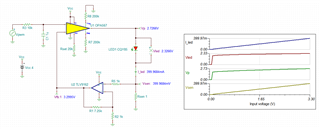Other Parts Discussed in Thread: TLV9161
Hello,
I would like to drive an LED with the OPA567 (up to 500mA). The OPA567 is wired as non-inverted OPA -> 0 ... 3,3V input. Directly at the OPA567 output (PIN 2,3) an POWER-LED is placed. After the LED, a current measuring resistor (1 Ohm) is connected to GND. A 2nd OPA, a TLV9161, is used for feedback as a non-inverting OPA to the INV-PIN (8) of the OPA567 and amplifies the measuring voltage of the current measuring resistor (V=8,25). The TLV9161 operates as a non-inverting OPA. Can I choose this circuitry. There is no negative supply voltage present.
Can I use this arrangement ( 2 x non-inverting OPV, only + 4V and GND as power supply) to ensure the level control of the OPAs.? I have concern because the OPA567 can not work near the rail boundaries?
Regards
Heiko


